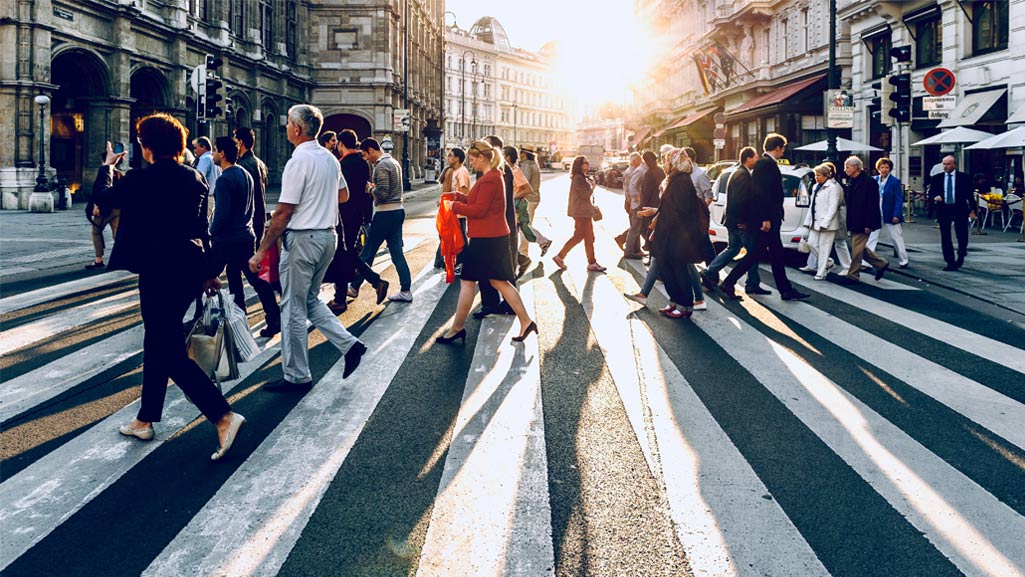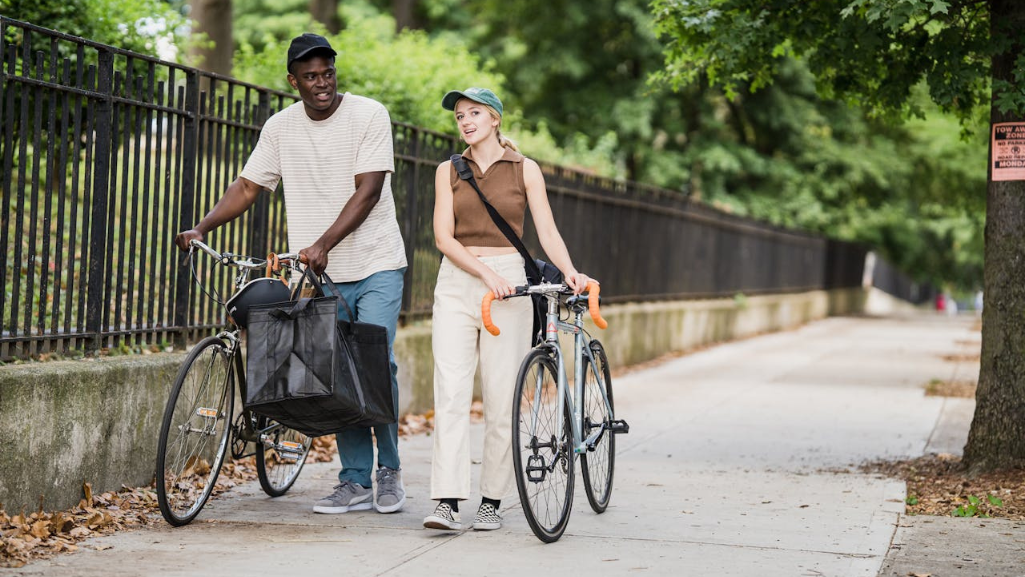Healthy, environmentally friendly, free of charge: Walking offers many benefits. At least theoretically. But in practice, pedestrians sometimes have the impression that they do not have the same rights as the other road users. There are cars parked across the pavements, short green waves at traffic lights and zebra crossings often seem more of a decorative element of the road infrastructure. But perhaps the classic form of mobility will soon experience a renaissance.
Walking used to be of great importance. For example, Peripatos (περίπατος), the name of the philosophical school of Aristotle, means ‘promenade’, which reflects the place of teaching. Through writers such as Poe, Baudelaire, Apollinaire, Hessel and many others, the pedestrian found his way into literature: as a stroller who observes and reflects on life in the big city. Pavements and – even more comfortable – arcades and passages offered safety and protection from horse and cart traffic. But with the triumphant progress of the car, the interests and safety of pedestrians became subordinated.
Pedestrians get a raw deal
“Pavements are also the most neglected and disregarded transport routes. Sometimes they are even non-existent. And in most cases, they are no more than narrow strips – the space that remains after all the others were served. Their original width is often decimated by parking lots and cycle paths, light poles and telecom boxes, pub tables and advertising signs, bus stops and garbage cans. Moreover, they are used by cyclists and car drivers, parking their cars on the pavement; and they are the last thing on the agenda of public works departments and snow clearing services.” This is how Fuss e. V. the German professional association for pedestrian traffic describes the disadvantages of decades of car-focused traffic planning and the problems that pedestrians have to face. Together with many other national organizations, Fuss e. V. is part of the International Federation of Pedestrians (IFP). This network of non-profit associations and individuals from all over the world was founded in 1963 and has been promoting the rights of pedestrians ever since. The vision of the IFP is to create a “world that is inviting, safe and comfortable for all to walk”, as they state on their website. This requires pedestrian-friendly concepts – ultimately, when we start or finish our trip, it’s always on foot.
There is definitely a growing awareness of the issues’ importance to our daily lives. Especially since walking is one of the most common forms of mobility.
A lot of walking in Europe
Who walks the most in Europe? According to “Living. Moving. Breathing.” [Santhosh Kodukula et al., Wuppertal Institute 2018] the Parisians with a 41% share of trips made on foot, followed by Amsterdam and Berlin – each with a 31% share. Then Madrid (30%), Oslo (28%), Zurich and Vienna (each 27%), Brussels (25%), London (24%). Rome (6%) and Moscow (3%) have the lowest share of trips made on foot.
The results of the ‘Mobility in Germany (MiD) 2017’ survey, published by the Federal Ministry of Transport and Digital Infrastructure (BMVI) in late 2018, show, that Germans travel around 3.2 billion kilometres a day, i.e. 39 kilometres per person per day. Most of them by car, which alone covers three quarters of passenger kilometres and 57% of all journeys. With a share of 22%, pedestrian traffic is twice as high as cycle traffic (11%). Public transport (10%) is even lower. This makes walking the second most popular means of transport.
But there’s more: Almost half of all car journeys are shorter than five kilometres, one in four is shorter than two kilometres and one in ten is even shorter. If one assumes that one kilometre takes 15 minutes on foot, one is not faster when travelling by car through city traffic, including the search for a parking lot. Alternative forms of mobility, such as walking, are particularly helpful and effective in cities that have to cope with high traffic volumes and their consequences (pollutant emissions, noise, congested roads, lack of parking space). Modern mobility concepts therefore attempt to make the various means of transport more equitable in terms of planning.
Pedestrian-friendly instead of car-focused
“For some years now, mobility concepts for small to medium-sized cities have been reflecting the growing trend towards the integration of pedestrian traffic,” says Christoph Schulze, Head of Transport Planning and Technology at PTV Transport Consult. He is working on two mobility concepts, which were presented to the respective municipalities in April 2019: Landau and Bad Dürkheim, Germany. With regard to pedestrian traffic, it is important to address topics, such as safety and accessibility, on the one hand and attractive connections for pedestrians throughout the city on the other. “No one wants to make detours,” explains Schulze. Improving the conditions for pedestrian traffic can also be tricky in cities with historic street environments such as Bad Dürkheim. “Due to the city’s narrow streets, which were designed for efficient handling of motor vehicle traffic, it is necessary to make compromises. For example, the minimum requirements in terms of widths for pedestrian, cycle and car traffic cannot be met. Therefore, one-way streets could be a way of creating space for all road users,” says Schulze.
For both mobility concepts, pedestrian traffic was taken into account as a fully-fledged component of mobility behaviour. However, according to Schulz, cities have a lot of catching up to do. “The shift from car to pedestrian traffic is definitely an effective contribution to environmental and climate protection.”
Studying pedestrian traffic in Europe
The researchers involved in the EU project FLOW (Furthering Less Congestion by Creating Opportunities for more Walking and Cycling) are also aware of this fact. The aim of the project was to reduce traffic jams in cities and make passenger transport more sustainable, both financially and ecologically. Important measures included: Walking and cycling or improving the conditions for these modes of transport.
Nora Szabo, who managed the project on the PTV side, says: “We used special software tools to examine the impact of congestion reduction measures on the six cities participating in the project: Budapest, Dublin, Gdynia, Lisbon, Munich and Sofia. The tools included PTV Vissim for traffic simulation, PTV Viswalk for pedestrian simulation and PTV Visum for transport planning. The scenarios required further development of the software to better map the shared space concept in PTV Vissim and PTV Viswalk. PTV Visum was also further developed in order to realistically align bicycle traffic and include rental systems. Another important task for us was to develop an evaluation procedure to assess the macroeconomic impact of the measures on walking and cycling. Multimodal aspects were also taken into account. We have adapted this procedure to the needs of the partner cities.”
The twin city Lisbon is an excellent example of the positive effects of smart traffic solutions. The Portuguese capital, with its narrow historic streets, offers little space for pedestrian traffic. Here, too, an essential part is dedicated to car and parking traffic. The narrow pavements are particularly problematic, especially for people with shopping bags, prams or walking aids.
As part of the FLOW project, Lisbon modelled and analysed several measures and their impact: longer green phases for pedestrians, underpasses and viaducts replaced by road crossings, and more space for pedestrians by widening pavements or streets intended for pedestrians and cyclists only. The vision of a more pedestrian-friendly city is of course a ‘work in progress’, but based on the results of the 3D animations in PTV Vissim, 30 different measures have already been taken to improve pedestrian traffic. The overall pedestrian network has been significantly enhanced in terms of safety, accessibility, convenience and attractiveness of the routes. These are important prerequisites for persuading even more people to walk. Click here to read the detailed project report.
In 2011, Bolivia introduced the National Day of Pedestrians and Cyclists for the Protection of Mother Earth (Día nacional del peatón y del ciclista en defensa de la Madre Tierra), which takes place on the first Sunday in September. With a few exceptions, there are no motorized vehicles on the roads for several hours during this day. The National Pedestrian Day is celebrated annually in Indonesia on January 22. The cost-intensive improvement of the infrastructure for pedestrian traffic is intended to encourage people to use the sidewalk. In 2019, California designated September as the official month for pedestrian safety (Pedestrian Safety Month). Perhaps there will soon be an international day for pedestrians, turning streets into places to play and stroll around.
Cities must offer attractive and safe routes for pedestrians. And cities need many more pedestrians in order to be able to contain their environmental problems. A win-win situation for everyone involved.



